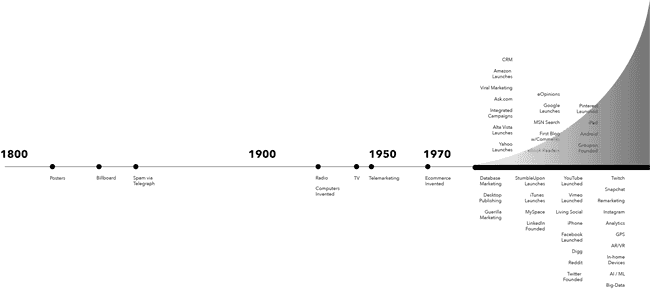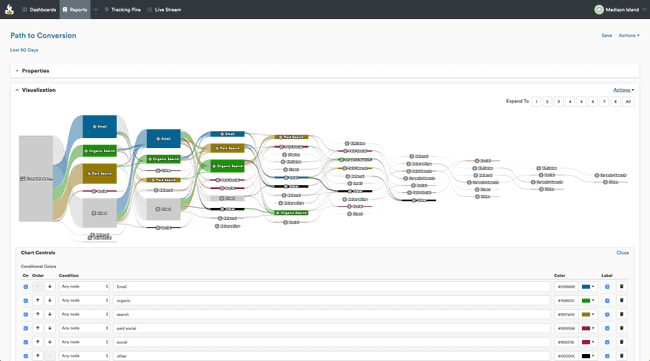The Combustible Combination of Complexity
Multi-device, demand-driven, and always connected consumers have become the new norm. Customer journeys are more unpredictable than ever. Marketing mediums and channels that were the darlings of the industry have imploded and been replaced in the latest hype cycles.
 Figure 1 - Marketing Technology and Channel Growth Over Time
Figure 1 - Marketing Technology and Channel Growth Over Time
To win, marketers have had to start engineering success to cost-effectively meet their goals. Through the awareness, interest, decision and action phases of the customer journey, marketers must leverage available technologies to compete. That’s why we as consumers seem to get more emails and are remarketed to more aggressively than ever.
But as the playing field keeps shifting, the age old question still stands and is probably more relevant than ever: Half the money I spend on advertising is wasted, the problem is I don’t know which half. In other words, measuring ROI is still one of the most difficult challenges faced by marketing teams.
Attribution: The Age Old Question
In an environment where it takes several touch-points to convert a customer, across multiple channels, leveraging multiple technologies and tactics, what actually works? More importantly, how do these various factors work together? The results of answering this question should be obvious. If you are able to measure the impact of your multi-touch marketing, you can make the necessary adjustments to optimize for your objectives.
I’m often asked, “Mike, given they type of company we are, what attribution model should we use?” What they are really asking is what should they choose in the Google Analytics down-down for their multi-touch attribution report. This is the first problem.
The Heuristics
Back in 2016 an article was written in MarTec Today which described this evil: “A heuristic, by its nature, is a simplification of problem to more of a “rule of thumb,” removing complexity in favor of a quick analysis. In the case of attribution modelling, this means assigning values across positions in the chain, regardless of actual impact on the completion of a sale.”
The most common heuristic model plaguing marketers is “Last-Click”. This is partially due to its super simplification of the problem, and largely because it’s the default setting for virtually all analytics and marketing platforms.
This attribution model involves giving all of the credit to the last non-direct channel that resulted in a conversion. Here’s an example to illustrate:
 Figure 2 - An Example Customer Path-to-Purchase
Figure 2 - An Example Customer Path-to-Purchase
Reggie bought our Super Sound Headphones earlier today. He started his journey a few days ago with a Google Search for “great sounding headphones”. After visiting our site, we remarketed to him on Facebook and Instagram. He clicked on one of our ads and returned to the site, reviewing the specs about our headphones. This morning, the session in which he made his purchase, was started after he searched for “Super Sound Headphones” on Google and clicked on our branded paid search ad.
In this example, the credit for the sale would all be given to Paid Search. Seems to align with the MarTec description of an overly simplified approach that does not represent the true impact to conversion.
I think most marketers know that this approach is lousy. I suggest however that the other options in the “drop-down”, or the other heuristics are just as flawed. Whether it’s giving the credit to the first touchpoint, even distribution across all touches, coming up with a custom weighting, etc, getting into the head of a customer requires something more sophisticated.
The Untrackables
The other challenge facing marketing attribution involves what I call the “untrackables”. The untrackables consist of non-interaction events, both digital and offline. They are a factor when it comes to attribution - but if you can’t measure something it cant be included in the model. Examples include out-of-home advertising or direct mail in the offline world, and non-clicked display advertising in the digital world.
That said there are a number of strategies that can be used better measure the Untrackables, which in fact are often trackable by leveraging the right techniques. I’ve talked about this in articles about view-through attribution and reconciling on-line and offline data.
Heuristics to Statistics
So the question still stands, how do we know what marketing is working given the complexity of customer journeys?
To illustrate what we’re trying to do, namely understand what touch-points should be credited in a conversion, check out the following image that shows what all the paths to purchase look like for a typical brand. The left-most box illustrates the conversion event, a purchase, and the paths illustrate the flow of people across touch-points (search, social, paid search, email etc).
 Figure 3 - (Non)Typical Paths to Purchase
Figure 3 - (Non)Typical Paths to Purchase
As much as us marketers love the ability to simplify, this image illustrates that when it comes to attribution, it’s too difficult for us as humans to do so. Luckily however, we have machines that allows us to leverage technology and data. We can get the simple answers we’re looking for without sacrificing accuracy and resolution.
There are several data-driven or algorithmic attribution models out there. At Trialfire we’ve implemented an approach based on collaborative game theory. One of the primary reasons we’ve done so is because it’s not a black box. This means that you can explain how the model works, and with that understanding comes the confidence to make decisions based on what the model tells us.
Why it Works
The game theory attribution model we use at Trialfire is based on the Shapley value formula. The Shapley Value was developed by economics Nobel Laureate Lloyd Shapley as an approach to fairly distributing the output of a team among the players.
I’m not going to go into the how because it involves a lot of advanced math and statistics, but instead I’ll cover why this the optimal approach to marketing attribution.
The “players”, in our case, are the marketing touch points, and the output is of course the dollars tied to conversions. It works by looking at the statistical performance of combinations of players and fairly rewards them when they contribute to a win. Thus marketing efforts that are top of funnel, bottom of funnel and everything in between are rewarded based on their contribution to the sale.
Shapley is also great at picking up on touch-points that do nothing at all. For example, organic search is often seen on the path to conversion, but just because it’s there doesn’t mean it provides “lift”. Organic is often overvalued by last-click models but Shapley takes those attribution dollars and fairly assigns them to the correct channels.
The Path to Success
It’s truly an exciting time to be a data-driven marketer. The panacea of true return on ad spend is finally within our grasp. Is it a perfect solution? No, but it stands head and shoulders above every attribution model rooted in heuristics. It’s the only model that can keep up with the ever changing customer journey and arms marketers with a valuable tool in this era of combustible complexity.
We’d love to talk to you about your attribution challenges or successes, and share more about how we’ve implemented data-driven attribution with various types of organizations. Feel free to reach out via email or to schedule a call.
